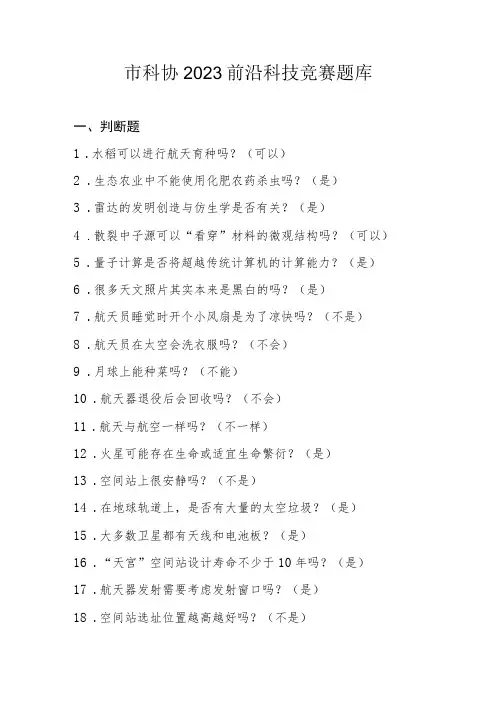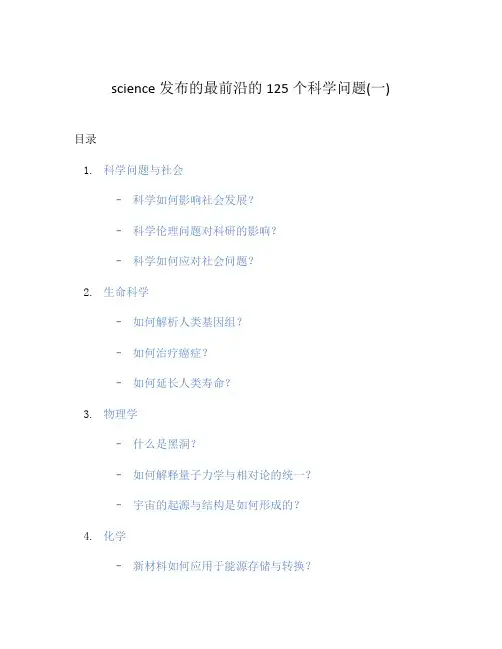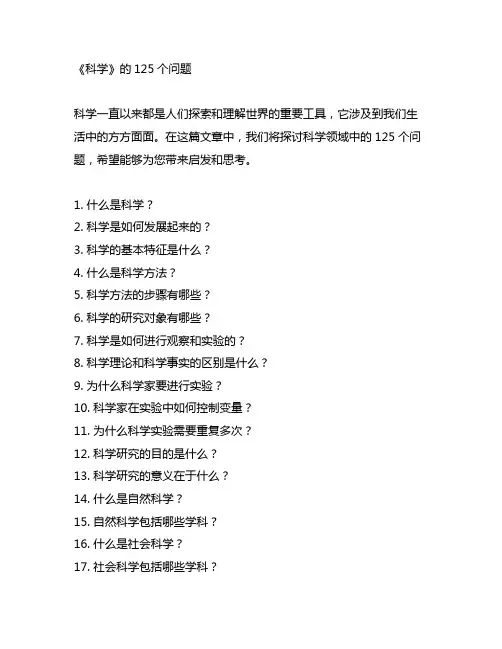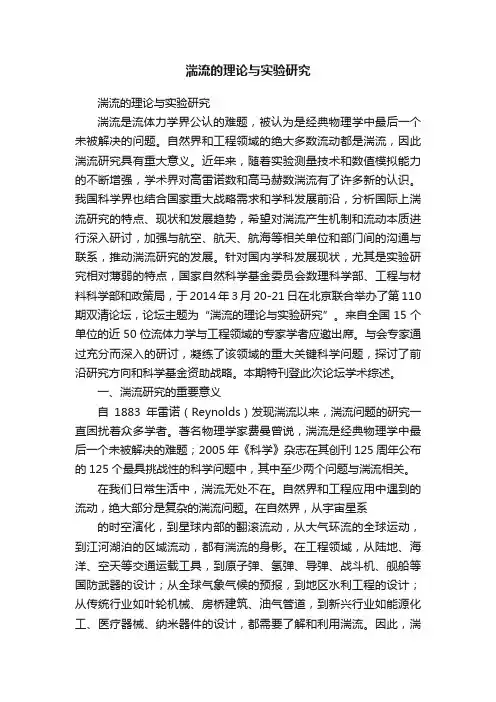125个最具挑战性的科学问题
- 格式:docx
- 大小:19.25 KB
- 文档页数:3

以下是125个科学问题的分类和特点:1. 物理问题:物理学是研究物质和能量以及它们之间相互作用规律的学科。
物理问题涉及物质的基本性质、运动规律、电磁场、粒子物理、相对论等方面。
物理问题的特点是抽象、理论性强,需要通过实验验证。
2. 化学问题:化学是研究物质组成、结构、性质和变化的学科。
化学问题涉及化学键、分子结构、化学反应、化学平衡等方面。
化学问题的特点是实验性较强,需要使用化学试剂和实验设备进行实验。
3. 生物问题:生物学是研究生命现象和生命本质的学科。
生物问题涉及细胞结构与功能、基因与蛋白质、生物进化、生态学等方面。
生物问题的特点是具体、复杂,需要借助实验和观察进行研究。
4. 地球科学问题:地球科学是研究地球地质、地貌、气候、水文等自然现象的学科。
地球科学问题涉及地球的起源、演变和未来趋势,以及地球上发生的自然灾害等方面。
地球科学问题的特点是综合性强,需要多学科交叉进行研究。
5. 天文学问题:天文学是研究宇宙中天体和宇宙现象的学科。
天文学问题涉及恒星、行星、星系、宇宙起源和演化等方面。
天文学问题的特点是观测性强,需要借助望远镜等观测设备进行研究。
6. 数学问题:数学是研究数量、结构、变化等概念的抽象学科。
数学问题涉及算术、代数、几何、概率论等方面。
数学问题的特点是逻辑性强,需要使用数学方法和符号进行推导和研究。
7. 工程科学问题:工程科学是研究如何应用科学原理和技术来解决实际工程问题的学科。
工程科学问题涉及材料科学、机械工程、电子工程、计算机科学等方面。
工程科学问题的特点是实践性强,需要进行实验和模拟来解决实际问题。
8. 环境科学问题:环境科学是研究人类活动与自然环境相互关系的学科。
环境科学问题涉及环境保护、生态修复、可持续发展等方面。
环境科学问题的特点是综合性强,需要多学科交叉进行研究,并关注人类活动对环境的影响。
9. 医学问题:医学是研究人类生理、病理和疾病的学科。
医学问题涉及人体解剖学、生理学、病理学、药理学等方面。

市科协2023前沿科技竞赛题库一、判断题1.水稻可以进行航天育种吗?(可以)2.生态农业中不能使用化肥农药杀虫吗?(是)3.雷达的发明创造与仿生学是否有关?(是)4.散裂中子源可以“看穿”材料的微观结构吗?(可以)5.量子计算是否将超越传统计算机的计算能力?(是)6.很多天文照片其实本来是黑白的吗?(是)7.航天员睡觉时开个小风扇是为了凉快吗?(不是)8.航天员在太空会洗衣服吗?(不会)9.月球上能种菜吗?(不能)10.航天器退役后会回收吗?(不会)11.航天与航空一样吗?(不一样)12.火星可能存在生命或适宜生命繁衍?(是)13.空间站上很安静吗?(不是)14.在地球轨道上,是否有大量的太空垃圾?(是)15.大多数卫星都有天线和电池板?(是)16.“天宫”空间站设计寿命不少于10年吗?(是)17.航天器发射需要考虑发射窗口吗?(是)18.空间站选址位置越高越好吗?(不是)19.空间站的水会循环使用吗?(是)20.人类目前可以探测太阳系边界吗?(不可以)21.月球上是否存在水源?(是)22.如果木星的轨道发生改变,是否会影响地球?(是)23.航天员出舱活动是否要看天气预报?(是)24. “海丝二号”卫星拍到的2.6万多张图片,都是拍摄的地球上的海洋吗?(是)25.相比一般卫星,海洋卫星的轨道定位精度要求更高吗?(是)26. 2022年9月2日凌晨,韦布空间望远镜拍摄的第一张系外行星图像被公布,这颗系外行星的编号为“HIP65426b”吗?(是)27.大模型是指一种参数规模非常大的人工神经网络吗?(是)28.中国无人机产业快速发展,已广泛应用于快速物流、应急救援、农林植保、航空测绘吗?(是)29.通过分子选育,可以筛选获得以葡萄糖为原料能够高产细菌纤维素的菌株吗(是)30.帆电池不可能走出实验室开始商业应用吗?(不是)31. “夸父一号”卫星采用的是高度720千米左右、周期约99分钟的太阳同步晨昏轨道吗?(是)32.目前,几乎所有蛋白质的结构都可以通过AI智能平台来进行预测吗?(是)33.登陆火星的好奇号探测器是否使用了一台多用途放射性同位素温差同位素电池?(是)34.水产养殖的智能化依靠设施的现代化吗?(是)35.高分十二号03星是高分辨率对地观测系统国家科技重大专项安排的微波遥感卫星,主要用于国土普查、城市规划、土地确权、路网设计、农作物估产和防灾减灾等领域吗?(是)36.如今,在免疫学分析技术及全基因组学技术的助力下,可以很方便地从人的血液或淋巴结中获得免疫组分信息吗?(是)37.“中国天眼”是全球最大且最灵敏的双口径射电望远镜吗?(不是)38.液氧甲烷发动机是可重复使用的吗?(是)39.中国科学院空间应用工程与技术中心研制建设的电磁弹射微重力实验装置是亚洲首个电磁弹射微重力实验装置吗?(是)40. 2023年7月12日,NatUre重磅发布来自中国科学家的成果:发现镁氧化物中压力诱导的80K左右超导电性。

science发布的最前沿的125个科学问题(一)目录1.科学问题与社会–科学如何影响社会发展?–科学伦理问题对科研的影响?–科学如何应对社会问题?2.生命科学–如何解析人类基因组?–如何治疗癌症?–如何延长人类寿命?3.物理学–什么是黑洞?–如何解释量子力学与相对论的统一?–宇宙的起源与结构是如何形成的?4.化学–新材料如何应用于能源存储与转换?–如何实现可持续化学合成?–如何解决化学品安全问题?5.地球科学–如何预测自然灾害?–如何解决气候变化问题?–地球内部结构与演化过程是怎样的?问题与社会科学如何影响社会发展?科学作为人类认识世界和改变世界的一种重要方法,它的发展对社会产生了广泛的影响。
科学的进步推动了技术的发展,改善了生活质量,提高了生产效率。
同时,科学也对社会产生了一些负面影响,例如环境污染和社会不平等等问题。
科学伦理问题对科研的影响?科学研究中的伦理问题是指在科学实验和应用中可能涉及到的道德、法律和社会责任等方面的问题。
科学伦理的遵守是保证科学研究的可靠性和安全性的重要保障,不遵守科学伦理将会对研究结果产生负面影响,甚至引发严重的后果。
科学如何应对社会问题?科学在解决社会问题方面发挥着重要作用。
通过科学方法和技术手段,科学家可以研究和解决社会问题,例如医学研究可以改善健康状况,环境科学可以应对环境污染等。
同时,科学家也需要与政府、企业和社会各界紧密合作,共同应对复杂的社会问题。
生命科学如何解析人类基因组?解析人类基因组是生命科学中的重大挑战之一。
通过高通量测序技术和生物信息学分析,科学家可以研究人类基因组的构成和功能,揭示基因与健康、疾病之间的关系,为个性化医学和基因治疗提供重要依据。
如何治疗癌症?癌症是一种严重威胁人类健康的疾病,目前尚无彻底治愈癌症的方法。
科学家们不断研究癌症的发生机制和治疗方法,包括靶向药物治疗、免疫疗法和基因编辑等新技术,以提高癌症治疗的效果和生存率。
如何延长人类寿命?人类寿命延长是现代社会面临的重要问题。

游走手性世界作者:暂无来源:《科学中国人》 2017年第6期本刊记者倪海波2001年10月10日,瑞典皇家学院宣布,当年诺贝尔化学奖一半授予美国科学家威廉·诺尔斯与日本科学家野依良治,以表彰他们在“不对称催化氢化反应”领域做出的贡献;另一半授予美国科学家巴里·夏普莱斯,以表彰他在“不对称催化氧化反应”领域的贡献。
他们的成就,可以用共同的一个词来概括——手性。
手性,广泛存在于自然界中,小到微观电子的自旋、有机分子,大到星系旋臂、行星自转、大气气旋,手性覆盖了由生物分子到宇宙的绝大多数的天然产物。
如果某物体与其镜像不同,且其镜像不能与原物体重合,则其通常就会被称为具有“手性”。
那么,自然界中手性原则的起源是什么?这一问题甚至被《科学》杂志列为当今世界125个最具挑战性的科学问题之一,吸引了无数科学家的目光。
重庆大学药学院研究员魏为力就长期游走于“手性”世界里,致力于其追本溯源。
体验手性之美在重庆大学学习化学工程与工艺时,魏为力就爱上了科幻小说,比如科幻作家长铗的《674号公路》等。
仁者乐山,智者乐水,钟情科学的魏为力从这些书中看到的是“手性”与“生命体”的关系。
“这令我非常着迷,从而产生了极大的兴趣。
”魏为力说。
到2007年进入中国科学院生态环境研究中心后,他终于有机会全面接触手性,积极着手对一种生物大分子直链淀粉的多级手性进行研究。
初次尝试,他就在探索了直链淀粉的手性识别机理的基础上,进一步加深以直链淀粉为手性选择剂为研究对象,进行了毛细管电泳手性分离一系列药物对映体新方法的开发。
魏为力心中被初次尝试的“成就感”填满了,他更加意识到这已经是自己割舍不掉的一部分了,他也乐于去接受更多的挑战,比如关于色谱中“切换对映体的洗脱顺序”的考验。
这是由手性液相色谱柱的应用问题而引发的思考。
作为重要的针对对映体的分离与分析方法,手性液相色谱在生物、化学和医药等领域具有广泛的应用。
在手性药物制备等领域,通常希望含量较少的手性对映体先洗脱下来,以提高对映体的制备效率及纯度。

山药:植物界的传奇作者:王一行来源:《天天爱科学》2019年第08期早在公元前8000年,非洲和东南亚就开始栽培山药了。
而山药在其他国家迅速“安家落户”则是在奴隶贸易时期。
在非洲和亚洲的殖民地之间穿梭的葡萄牙商人,是山药得以在全世界传播的关键。
在远航中,他们发现了携带山药的好处:富含维生素A、维生素C、蛋白质和矿物质,而且耐存储。
随着山药的广泛传播,这种作物也成为了多国人民喜爱的食物。
另外,用山药的块茎调理身体的历史也非常悠久,尤其是在我国,应用得更为广泛。
那么山药到底是一种怎样的植物呢?春天时,在我每天经过的小径上,一种叶子为卵圆形、略带紫色的植物萌出了,不用猜,这就是山药。
山药是薯(shǔ)蓣(yù)的别称,为薯蓣科薯蓣属中的一种。
这看似不起眼的山药,其实是改变了世界的一种植物呢。
如果你恰巧看见了一株山药,不妨仔细观察一下山药叶子的生长方式,我想你多半会和我发出一样的感慨:真是琢磨不透呀!你会发现,在山药植株的基部,叶子是互生的,而植株中上部的叶子却是对生的,偶尔,你还会发现三片叶子轮生的情况。
山药叶子的生长方式为什么这样“任性”呢?山药是典型的单子叶植物。
单子叶植物有一个主要特征就是互生叶序。
那么为什么山药的叶子又出现了对生和轮生的情况呢?这是因为叶子是植物进行光合作用、蒸腾作用的主要器官,因此在必要时就需要增加绿叶的面积,以保证自己更快、更好地生长。
山药叶子的“任性”之处不仅体现在着生方式上,还体现在叶子的形状上:有的为规则的宽卵形,有的像心形,还有的则长成酷酷的三叉戟模样。
两点之间,直线最短,这是我们都知道的常识。
但山药似乎偏不喜欢走捷径,而是喜欢绕路而行,走“S”形路线。
用物理知识来讲,“S”形路线不是爬坡时最省力的方法吗?作为藤本植物的山药难道也懂物理学?山药的茎,或者说藤,通常呈紫红色,喜欢绕着攀附物进行螺旋式生长。
在我们周边有很多螺旋式生长的植物,但是如果你仔细观察,可以发现它们的生长方式还是有区别的:有的往左旋,有的往右旋。


《科学》列出十大人类未解答的科学问题在学术杂志《科学》125周年纪念刊上,列举出了迄今为止尚未解答的25个科学问题。
该刊物的主编唐纳德·肯尼迪解释说,这些都是“最难解答、最富挑战同时也是最能吸引人们的阅读兴趣,并启发读者思考‘到底答案是什么’”的问题。
这一排行榜的前10名分别是:宇宙是由什么构成的?近十年来,科学家已经发现构成恒星、行星甚至人体的基本物质只占整个宇宙中所有物质的百分之五。
其它的则属于科学家们刚刚才了解到的暗物质和暗能量。
那么暗物质是由什么构成的,它存在于何处?而什么又是暗能量?研究者希望能找到答案。
意识的生物基础是什么?早在17世纪,法国哲学家兼数学家勒奈·笛卡尔就指出思想和身体是完全分离的。
之后,其他哲学家对意识自然属性看发就一直存在争论。
今天的科学家则指出意识是来自大脑内部的神经细胞组织极其特性。
并以此观点来对笛卡尔观点提出挑战。
而分解这些特性和过程的实验性工作目前才刚刚开始。
格雷格·米勒在《科学》杂志的这期特刊上写道:“即便如果实验的结果不能为意识是如何从神经细胞的一片混乱中产生提供更深入的认识,它也能为此问题的下一轮提供参考。
”人类的寿命到底能延长到多长?如前,在对酵母、蠕虫以及老鼠进行寿命延长实验使一些科学家相信人类很快就能够很容易地超越目前100多岁的寿命记录。
而另一些科学家则认为人类寿命有可能更为有限。
珍妮弗·寇瑞恩在《科学》上所发表的一篇相关文章中指出,无论延长还是有限,人类寿命能够得到延长的可能性“可能会带来深远的社会效应”。
地球内部是如何活动的?革命性的大陆板块漂移学说——即认为地壳是有不同的板块构成的,板块的相互作用形成了目前的地表形态——所涉及的深度并不够深。
里查德·A·克尔写道:“剩下的还有6300公里厚的岩石以及构造板快下面的铁元素,它们的搅动推动着我们这颗行星的热能发动机内部的工作。
”随科学家不断采用更先进的设备对地球内部进行探索,研究者已经发现地球地壳下面的这台发动机是如此吸引人且复杂。

《科学》的125个问题科学一直以来都是人们探索和理解世界的重要工具,它涉及到我们生活中的方方面面。
在这篇文章中,我们将探讨科学领域中的125个问题,希望能够为您带来启发和思考。
1. 什么是科学?2. 科学是如何发展起来的?3. 科学的基本特征是什么?4. 什么是科学方法?5. 科学方法的步骤有哪些?6. 科学的研究对象有哪些?7. 科学是如何进行观察和实验的?8. 科学理论和科学事实的区别是什么?9. 为什么科学家要进行实验?10. 科学家在实验中如何控制变量?11. 为什么科学实验需要重复多次?12. 科学研究的目的是什么?13. 科学研究的意义在于什么?14. 什么是自然科学?15. 自然科学包括哪些学科?16. 什么是社会科学?17. 社会科学包括哪些学科?18. 什么是应用科学?19. 应用科学与基础科学有何区别?20. 科学的发展对人类社会的影响是什么?21. 科学技术是如何推动社会进步的?22. 为什么科学普及对社会至关重要?23. 科学教育的意义在于什么?24. 科学素养是什么?25. 为什么每个人都应该具备科学素养?26. 科学素养对个人和社会的影响是什么?27. 什么是科学道德?28. 科学道德的重要性是什么?29. 科学研究中的诚信和公正有何意义?30. 科学错误是如何纠正和修正的?31. 科学研究的权威性和可靠性如何保障?32. 科学研究的伦理问题是什么?33. 什么是伪科学?34. 如何识别伪科学?35. 伪科学的危害是什么?36. 为什么要避免伪科学?37. 什么是科学世界观?38. 科学世界观对认识世界的影响是什么?39. 什么是科学价值观?40. 科学价值观对人类社会的影响是什么?41. 什么是科学技术伦理?42. 科学技术伦理的重要性是什么?43. 科学研究中的社会责任是什么?44. 科学研究中的公共利益是什么?45. 科学研究中的隐私保护是什么?46. 科学研究中的安全风险是什么?47. 什么是科学革命?48. 科学革命对现代科学的影响是什么?49. 什么是科学精神?50. 科学精神对科学研究的意义是什么?51. 什么是科学探索的动力?52. 科学探索的动力对科学发展的影响是什么?53. 什么是科学技术创新?54. 科学技术创新对社会和经济的意义是什么?55. 什么是科学实验的基本要求?56. 科学实验的基本要求对实验结果的可靠性有何影响?57. 什么是科学研究的创新能力?58. 科学研究的创新能力的意义在于什么?59. 什么是科学研究的自主性?60. 科学研究的自主性对研究成果的影响是什么?61. 什么是科学研究的目标导向?62. 科学研究的目标导向对研究过程的影响是什么?63. 什么是科学研究的合作性?64. 科学研究的合作性对研究成果的影响是什么?65. 什么是科学研究的公开性?66. 科学研究的公开性对研究交流和合作的影响是什么?67. 什么是科学研究的符号语言?68. 科学研究的符号语言对科学交流的重要性是什么?69. 什么是科学研究的数据和信息?70. 科学研究的数据和信息对科学研究的意义是什么?71. 什么是科学研究的实践能力?72. 科学研究的实践能力对科学问题的解决有何影响?73. 什么是科学研究的逻辑推理能力?74. 科学研究的逻辑推理能力对科学证明的重要性是什么?75. 什么是科学研究的批判思维能力?76. 科学研究的批判思维能力对科学发现的意义是什么?77. 什么是科学研究的创造力?78. 科学研究的创造力对科学发展的推动作用是什么?79. 什么是科学研究的交流能力?80. 科学研究的交流能力对科学交流和合作的重要性是什么?81. 什么是科学研究的批判性思维?82. 科学研究的批判性思维对科学发现的意义是什么?83. 什么是科学研究的透明性?84. 科学研究的透明性对科学研究结果的可信度有何影响?85. 什么是科学研究的效率和效果?86. 科学研究的效率和效果对科学成果的意义是什么?87. 什么是科学研究的风险管理?88. 科学研究的风险管理对科学实验和研究的安全性有何影响?89. 什么是科学研究的责任和义务?90. 科学研究的责任和义务对科学家和科研机构的影响是什么?91. 什么是科学研究的伦理标准?92. 科学研究的伦理标准对研究过程和结果的影响是什么?93. 什么是科学研究的法律规定?94. 科学研究的法律规定对研究活动和成果的约束和保护作用是什么?95. 什么是科学研究的政策和规划?96. 科学研究的政策和规划对科学研究资源的分配和利用有何影响?97. 什么是科学研究的知识产权保护?98. 科学研究的知识产权保护对科学研究成果的转化和应用有何意义?99. 什么是科学研究的社会审查和监督?100. 科学研究的社会审查和监督对科学研究的公正和公信力有何影响?101. 什么是科学研究的质量评价和控制?102. 科学研究的质量评价和控制对科研成果的评价和应用管理有何意义?103. 什么是科学研究的国际合作?104. 科学研究的国际合作对科学成果的国际传播和影响有何意义?105. 什么是科学研究的跨学科和交叉研究?106. 科学研究的跨学科和交叉研究对科学发现和创新的推动作用是什么?107. 什么是科学研究的大科学项目?108. 科学研究的大科学项目对科学研究资源的集中配置和科学技术的发展有何影响?109. 什么是科学研究的基础理论和应用技术?110. 科学研究的基础理论和应用技术对科学研究发展和社会进步的重要性是什么?111. 什么是科学研究的重大科学问题和前沿研究领域?112. 科学研究的重大科学问题和前沿研究领域对科学发展和创新的引领作用是什么?113. 什么是科学研究的战略性布局和规划?114. 科学研究的战略性布局和规划对科学发展和国家安全战略的影响是什么?115. 什么是科学研究的科学与艺术结合?116. 科学研究的科学与艺术结合对科学研究优秀人才的培养和科学教育的推动作用是什么?117. 什么是科学研究的科技成果转化和产业化?118. 科学研究的科技成果转化和产业化对科学研究成果的应用和社会经济的发展作用是什么?119. 什么是科学研究的科学传播和科学普及?120. 科学研究的科学传播和科学普及对科学知识的传播和社会公众的科学素养提高作用是什么?121. 什么是科学研究的科学家形象和科学精神?122. 科学研究的科学家形象和科学精神对科学工作者的激励和科学研究的推动作用是什么?123. 什么是科学研究的科学伦理和科学修养?124. 科学研究的科学伦理和科学修养对科学家的行为规范和科学研究成果的可信度保障作用是什么?125. 什么是科学研究的科学未来和科学梦想?126. 科学研究的科学未来和科学梦想对科学研究的持续创新和科学研究的发展动力是什么?结语:科学研究是为了寻求真理和创新的一种探索活动,它是人类对世界认识和理解的重要途径。

湍流的理论与实验研究湍流的理论与实验研究湍流是流体力学界公认的难题,被认为是经典物理学中最后一个未被解决的问题。
自然界和工程领域的绝大多数流动都是湍流,因此湍流研究具有重大意义。
近年来,随着实验测量技术和数值模拟能力的不断增强,学术界对高雷诺数和高马赫数湍流有了许多新的认识。
我国科学界也结合国家重大战略需求和学科发展前沿,分析国际上湍流研究的特点、现状和发展趋势,希望对湍流产生机制和流动本质进行深入研讨,加强与航空、航天、航海等相关单位和部门间的沟通与联系,推动湍流研究的发展。
针对国内学科发展现状,尤其是实验研究相对薄弱的特点,国家自然科学基金委员会数理科学部、工程与材料科学部和政策局,于2014年3月20-21日在北京联合举办了第110期双清论坛,论坛主题为“湍流的理论与实验研究”。
来自全国15个单位的近50位流体力学与工程领域的专家学者应邀出席。
与会专家通过充分而深入的研讨,凝练了该领域的重大关键科学问题,探讨了前沿研究方向和科学基金资助战略。
本期特刊登此次论坛学术综述。
一、湍流研究的重要意义自1883年雷诺(Reynolds)发现湍流以来,湍流问题的研究一直困扰着众多学者。
著名物理学家费曼曾说,湍流是经典物理学中最后一个未被解决的难题;2005年《科学》杂志在其创刊125周年公布的125个最具挑战性的科学问题中,其中至少两个问题与湍流相关。
在我们日常生活中,湍流无处不在。
自然界和工程应用中遇到的流动,绝大部分是复杂的湍流问题。
在自然界,从宇宙星系的时空演化,到星球内部的翻滚流动,从大气环流的全球运动,到江河湖泊的区域流动,都有湍流的身影。
在工程领域,从陆地、海洋、空天等交通运载工具,到原子弹、氢弹、导弹、战斗机、舰船等国防武器的设计;从全球气象气候的预报,到地区水利工程的设计;从传统行业如叶轮机械、房桥建筑、油气管道,到新兴行业如能源化工、医疗器械、纳米器件的设计,都需要了解和利用湍流。
因此,湍流流动的研究不仅仅是一个学科发展的问题,更具有重要的工程应用价值。

Science杂志提出的125个重要科学问题1. 宇宙是由什么构成?2. 意识的生物学基础是什么?3. 为什么人类基因会如此之少?4. 遗传变异与人类健康的相关程度如何?5. 物理定律能否统一?6. 人类寿命到底可以延长多久?7. 是什么控制着器官再生?8. 皮肤细胞如何成为神经细胞?9. 单个体细胞怎样成为整株植物?10. 地球内部如何运行?11. 地球人类在宇宙中是否独一无二?12. 地球生命在何处产生、如何产生?(进化论的发展)13. 什么决定了物种的多样性?14. 什么基因的改变造就了独特的人类?15. 记忆如何存储和恢复?16. 人类合作行为如何发展?17. 怎样从海量生物数据中产生大的可视图片?18. 化学自组织的发展程度如何?19. 什么是传统计算的极限?20. 我们能否有选择地切断某些免疫反应?21. 量子不确定性和非局部性背后是否有更深刻的原理?22. 能否研制出有效的HTV疫苗?(一定可以获得诺贝尔奖)23. 温室效应会使地球温度达到多高?(全球变化的内容)24. 什么时间用什么能源可以替代石油?(能源危机的内容)25. 地球到底能负担多少人口?(人口论与资源环境的内容)26. 宇宙是否唯一?27. 是什么驱动宇宙膨胀?28. 第一颗恒星与星系何时产生、怎样产生?29. 超高能宇宙射线来自何处?30. 是什么给类星体提供动力?31. 黑洞的本质是什么?32. 正物质为何多于反物质?33. 质子会衰减吗?34. 重力的本质是什么?35. 时间为何不同于其他维度?36. 是否存在比夸克更小的基本粒子?37. 中微子是其自己的反粒子吗?38. 是否有解释所有相关电子系统的统一理论?39. 人类能够制造最强的激光吗?40. 能否制造完美的光学透镜?41. 是否可能制造出室温下的磁性半导体?42. 什么是高温超导性之后的成对机制?43. 能否发展关于湍流动力学和颗粒材料运动学的综合理论?44. 是否存在稳定的高原子量元素?45. 固体中是否有超流动性?如果有,如何解释?46. 水的结构如何?47. 玻璃态物质的本质是什么?48. 是否存在合理化学合成的极限?49. 光电电池的最终效率如何?50. 核聚变将最终成为未来的能源吗?51. 驱动太阳磁周期的原因是什么?52. 行星怎样形成?53. 是什么引发了冰期?(气候变化的内容)54. 使地球磁场逆转的原因是什么?(古地理内容和地球内部探测的内容)55. 是否存在有助于预报的地震先兆?(地球内部深度探测计划的发展)56. 太阳系的其他星球上现在和过去是否存在生命?57. 自然界中手性原则的起源是什么?58. 能否预测蛋白质折叠?59. 人体中的蛋白质有多少存在方式?60. 蛋白质如何发现其作用对象?61. 细胞死亡有多少种形式?62. 是什么保持了细胞内的通行顺畅?63. 为什么细胞的成分可以独立于DNA而自行复制?64. 基因组中功能不同于RNA的角色是什么?65. 基因组中端粒和丝粒的作用是什么?66. 为什么一些基因组很大,另一些又相当紧凑?67. 基因组中的“垃圾”(“junk”)有何作用?68. 新技术能使RNA测序的成本降低多少?69. 器官核整个有机体如何了解停止生长的时间?70. 除了继承突变,基因组如何改变?71. 在胚胎期,不对称现象是如何确定的?72. 翼、鳍核面孔如何发育进化?73. 是什么引发了青春期?74. 干细胞是否位于所有肿瘤的中心?75. 肿瘤更容易通过免疫进行控制吗?76. 肿瘤的控制比治愈是否更容易?77. 炎症是所有慢性疾病的主要原因吗?78. 疯牛病会怎样发展?79. 脊椎动物在多大程度上依赖先天免疫系统来抵抗传染病?80. 对抗原而言,免疫记忆需要延长暴露吗?81. 为什么孕妇的免疫系统不拒绝其胎儿?82. 什么与有机体的生物钟同步?83. 迁徙生物怎样发现其迁移路线?84. 为什么要睡眠?85. 人类为什么会做梦?86. 语言学习为什么存在临界期?87. 信息素影响人类行为吗?88. 一般麻醉剂如何发挥作用?89. 导致精神分裂症的原因是什么?90. 引发孤独症的原因是什么?91. 阿兹海默症患者的生命能够延续多久?92. 致瘾的生物学基础是什么?93. 大脑如何建立道德观念?94. 通过计算机进行学习的极限是什么?95. 又多少个性源于遗传?96. 性别倾向的生物学根源是什么?97. 生命树是生命之间系统关系最好的表达方式吗?98. 地球上又多少物种?99. 什么是物种?100. 横向转移为什么会发生在众多的物种中以及如何发生? 101. 谁是世界的共同祖先?102. 植物的花朵如何进化?103. 植物怎样制造细胞壁?104. 如何控制植物生长?105. 为什么所有的植物不能免疫一切疾病?106. 外界压力环境下,植物的变异基础是什么?107. 是什么引起物质消失?108. 能否避免物种消亡?109. 一些恐龙为什么如此庞大?110. 生态系统对全球变暖的反应如何?111. 至今共有多少人种,他们之间有何关联?112. 是什么提升了现代人类的行为?113. 什么是人类文化的根源?114. 语言和音乐演化的根源是什么?115. 什么是人种,人种如何进化?116. 为什么一些国家向前发展,而有些国家的发展停滞? 117. 政府高额赤字对国家利益和经济增长速度有什么影响? 118. 政治与经济自有密切相关吗?119. 为什么改变撒哈拉地区贫困状态的努力几乎全部失败?120. 有没有简单的方法确定椭圆曲线是否存在无穷多解?121. 霍奇闭链是代数闭链的和吗?122. 数学家将会最终给出Navier-Stokes方程的解吗?123. 庞加莱实验能否确定4维空间的球?124. 黎曼zeta函数的零解都有a+bi形式吗?125. 对粒子物理标准模型的研究是否会停止在量子Yang-Mills理论上?。

湍流的理论与实验研究湍流是流体力学界公认的难题,被认为是经典物理学中最后一个未被解决的问题。
自然界和工程领域的绝大多数流动都是湍流,因此湍流研究具有重大意义。
近年来,随着实验测量技术和数值模拟能力的不断增强,学术界对高雷诺数和高马赫数湍流有了许多新的认识。
我国科学界也结合国家重大战略需求和学科发展前沿,分析国际上湍流研究的特点、现状和发展趋势,希望对湍流产生机制和流动本质进行深入研讨,加强与航空、航天、航海等相关单位和部门间的沟通与联系,推动湍流研究的发展。
针对国内学科发展现状,尤其是实验研究相对薄弱的特点,国家自然科学基金委员会数理科学部、工程与材料科学部和政策局,于2014年3月20-21日在北京联合举办了第110期双清论坛,论坛主题为“湍流的理论与实验研究”。
来自全国15个单位的近50位流体力学与工程领域的专家学者应邀出席。
与会专家通过充分而深入的研讨,凝练了该领域的重大关键科学问题,探讨了前沿研究方向和科学基金资助战略。
本期特刊登此次论坛学术综述。
一、湍流研究的重要意义自1883年雷诺(Reynolds)发现湍流以来,湍流问题的研究一直困扰着众多学者。
著名物理学家费曼曾说,湍流是经典物理学中最后一个未被解决的难题;2005年《科学》杂志在其创刊125周年公布的125个最具挑战性的科学问题中,其中至少两个问题与湍流相关。
在我们日常生活中,湍流无处不在。
自然界和工程应用中遇到的流动,绝大部分是复杂的湍流问题。
在自然界,从宇宙星系的时空演化,到星球内部的翻滚流动,从大气环流的全球运动,到江河湖泊的区域流动,都有湍流的身影。
在工程领域,从陆地、海洋、空天等交通运载工具,到原子弹、氢弹、导弹、战斗机、舰船等国防武器的设计;从全球气象气候的预报,到地区水利工程的设计;从传统行业如叶轮机械、房桥建筑、油气管道,到新兴行业如能源化工、医疗器械、纳米器件的设计,都需要了解和利用湍流。
因此,湍流流动的研究不仅仅是一个学科发展的问题,更具有重要的工程应用价值。
Science 1 July 2005, Vol. 309, 78-102The Top 25 big questions facing scienceover the next quarter-century.What Is the Universe Made Of?What is the Biological Basis of Consciousness?Why Do Humans Have So Few Genes?To What Extent Are Genetic Variation and Personal Health Linked?Can the Laws of Physics Be Unified?How Much Can Human Life Span Be Extended?What Controls Organ Regeneration?How Can a Skin Cell Become a Nerve Cell?How Does a Single Somatic Cell Become a Whole Plant? How Does Earth's Interior Work?Are We Alone in the Universe?How and Where Did Life on Earth Arise?What Determines Species Diversity?What Genetic Changes Made Us Uniquely Human?How Are Memories Stored and Retrieved?How Did Cooperative Behavior Evolve?How Will Big Pictures Emerge from a Sea of Biological Data? How Far Can We Push Chemical Self-Assembly? What Are the Limits of Conventional Computing?Can We Selectively Shut Off Immune Responses?Do Deeper Principles Underlie Quantum Uncertainty and Nonlocality?Is an Effective HIV Vaccine Feasible?How Hot Will the Greenhouse World Be?What Can Replace Cheap Oil -- and When?Will Malthus Continue to Be Wrong?So Much More to Know … Some of the following 100 questions will drive scientific inquiry for the next century; others may soon be answered.1. Is ours the only universe?A number of quantum theorists and cosmologists are trying to figure out whether our universe is part of a bigger "multiverse." But others suspect that thishard-to-test idea may be a question for philosophers.2. What drove cosmic inflation?In the first moments after the big bang, the universe blew up at an incredible rate. But what did the blowing? Measurements of the cosmic microwave background and other astrophysical observations are narrowing the possibilities.3. When and how did the first stars and galaxies form?The broad brush strokes are visible, but the fine details aren't. Data from satellites and ground-based telescopes may soon help pinpoint, among other particulars, when the first generation of stars burned off the hydrogen "fog" that filled the universe.4. Where do ultrahigh-energy cosmic rays come from?Above a certain energy, cosmic rays don't travel very far before being destroyed. So why are cosmic-ray hunters spotting such rays with no obvious source within our galaxy?5. What powers quasars?The mightiest energy fountains in the universe probably get their power from matter plunging into whirling supermassive black holes. But the details of what drives their jets remain anybody's guess.6. What is the nature of black holes?Relativistic mass crammed into a quantum-sized object? It's a recipe for disaster--and scientists are still trying to figure out the ingredients.7. Why is there more matter than antimatter?To a particle physicist, matter and antimatter are almost the same. Some subtle difference must explain why matter is common and antimatter rare.8. Does the proton decay?In a theory of everything, quarks (which make up protons) should somehow be convertible to leptons (such as electrons)--so catching a proton decaying into something else might reveal new laws of particle physics.9. What is the nature of gravity?It clashes with quantum theory. It doesn't fit in the Standard Model. Nobody has spotted the particle that is responsible for it. Newton's apple contained a whole can of worms.10. Why is time different from other dimensions?It took millennia for scientists to realize that time is a dimension, like the three spatial dimensions, and that time and space are inextricably linked. The equations make sense, but they don't satisfy those who ask why we perceive a "now" or why time seems to flow the way it does.11. Are there smaller building blocks than quarks?Atoms were "uncuttable." Then scientists discovered protons, neutrons, and other subatomic particles--which were, in turn, shown to be made up of quarks and gluons. Is there something more fundamental still?12. Are neutrinos their own antiparticles?Nobody knows this basic fact about neutrinos, although a number of underground experiments are under way. Answering this question may be a crucial step to understanding the origin of matter in the universe.13. Is there a unified theory explaining all correlated electron systems?High-temperature superconductors and materials with giant and colossal magnetoresistance are all governed by the collective rather than individual behavior of electrons. There is currently no common framework for understanding them.14. What is the most powerful laser researchers can build? Theorists say an intense enough laser field would rip photons intoelectron-positron pairs, dousing the beam. But no one knows whether it's possible to reach that point.15. Can researchers make a perfect optical lens?They've done it with microwaves but never with visible light.16. Is it possible to create magnetic semiconductors that work at room temperature?Such devices have been demonstrated at low temperatures but not yet in a range warm enough for spintronics applications.17. What is the pairing mechanism behindhigh-temperature superconductivity?Electrons in superconductors surf together in pairs. After 2 decades of intense study, no one knows what holds them together in the complex, high-temperature materials.18. Can we develop a general theory of the dynamics of turbulent flows and the motion of granular materials?So far, such "nonequilibrium systems" defy the tool kit of statistical mechanics, and the failure leaves a gaping hole in physics.19. Are there stable high-atomic-number elements?A superheavy element with 184 neutrons and 114 protons should be relatively stable, if physicists can create it.20. Is superfluidity possible in a solid? If so, how?Despite hints in solid helium, nobody is sure whether a crystalline material can flow without resistance. If new types of experiments show that such outlandish behavior is possible, theorists would have to explain how.21. What is the structure of water?Researchers continue to tussle over how many bonds each H2O molecule makes with its nearest neighbors.22. What is the nature of the glassy state?Molecules in a glass are arranged much like those in liquids but are more tightly packed. Where and why does liquid end and glass begin?23. Are there limits to rational chemical synthesis?The larger synthetic molecules get, the harder it is to control their shapes and make enough copies of them to be useful. Chemists will need new tools to keep their creations growing.24. What is the ultimate efficiency of photovoltaic cells? Conventional solar cells top out at converting 32% of the energy in sunlight to electricity. Can researchers break through the barrier?25. Will fusion always be the energy source of the future? It's been 35 years away for about 50 years, and unless the international community gets its act together, it'll be 35 years away for many decades to come.26. What drives the solar magnetic cycle?Scientists believe differing rates of rotation from place to place on the sun underlie its 22-year sunspot cycle. They just can't make it work in their simulations. Either a detail is askew, or it's back to the drawing board.27. How do planets form?How bits of dust and ice and gobs of gas came together to form the planets without the sun devouring them all is still unclear. Planetary systems around other stars should provide clues.28. What causes ice ages?Something about the way the planet tilts, wobbles, and careens around the sun presumably brings on ice ages every 100,000 years or so, but reams of climate records haven't explained exactly how.29. What causes reversals in Earth's magnetic field? Computer models and laboratory experiments are generating new data on how Earth's magnetic poles might flip-flop. The trick will be matching simulations to enough aspects of the magnetic field beyond the inaccessible core to build a convincing case.30. Are there earthquake precursors that can lead to useful predictions?Prospects for finding signs of an imminent quake have been waning since the 1970s. Understanding faults will progress, but routine prediction would require an as-yet-unimagined breakthrough.31. Is there--or was there--life elsewhere in the solar system?The search for life--past or present--on other planetary bodies now drivesNASA's planetary exploration program, which focuses on Mars, where water abounded when life might have first arisen.32. What is the origin of homochirality in nature?Most biomolecules can be synthesized in mirror-image shapes. Yet in organisms, amino acids are always left-handed, and sugars are always right-handed. The origins of this preference remain a mystery.33. Can we predict how proteins will fold?Out of a near infinitude of possible ways to fold, a protein picks one in just tens of microseconds. The same task takes 30 years of computer time.34. How many proteins are there in humans?It has been hard enough counting genes. Proteins can be spliced in different ways and decorated with numerous functional groups, all of which makes counting their numbers impossible for now.35. How do proteins find their partners?Protein-protein interactions are at the heart of life. To understand how partners come together in precise orientations in seconds, researchers need to know more about the cell's biochemistry and structural organization.36. How many forms of cell death are there?In the 1970s, apoptosis was finally recognized as distinct from necrosis. Some biologists now argue that the cell death story is even more complicated. Identifying new ways cells die could lead to better treatments for cancer and degenerative diseases.37. What keeps intracellular traffic running smoothly?Membranes inside cells transport key nutrients around, and through, various cell compartments without sticking to each other or losing their way. Insights into how membranes stay on track could help conquer diseases, such as cystic fibrosis.38. What enables cellular components to copy themselves independent of DNA? Centrosomes, which help pull apart paired chromosomes, and other organelles replicate on their own time, without DNA's guidance. This independence still defies explanation.39. What roles do different forms of RNA play in genome function?RNA is turning out to play a dizzying assortment of roles, from potentially passing genetic information to offspring to muting gene expression. Scientists are scrambling to decipher this versatile molecule.40. What role do telomeres and centromeres play in genome function?These chromosome features will remain mysteries until new technologies can sequence them.41. Why are some genomes really big and others quite compact?The puffer fish genome is 400 million bases; one lungfish's is 133 billion bases long. Repetitive and duplicated DNA don't explain why this and other size differences exist.42. What is all that "junk" doing in our genomes?DNA between genes is proving important for genome function and the evolution of new species. Comparative sequencing, microarray studies, and lab work are helping genomicists find a multitude of genetic gems amid the junk.43. How much will new technologies lower the cost of sequencing?New tools and conceptual breakthroughs are driving the cost of DNA sequencing down by orders of magnitude. The reductions are enabling research from personalized medicine to evolutionary biology to thrive.44. How do organs and whole organisms know when to stop growing?A person's right and left legs almost always end up the same length, and the hearts of mice and elephants each fit the proper rib cage. How genes set limits on cell size and number continues to mystify.45. How can genome changes other than mutations be inherited?Researchers are finding ever more examples of this process, called epigenetics, but they can't explain what causes and preserves the changes.46. How is asymmetry determined in the embryo?Whirling cilia help an embryo tell its left from its right, but scientists are stilllooking for the first factors that give a relatively uniform ball of cells a head, tail, front, and back.47. How do limbs, fins, and faces develop and evolve?The genes that determine the length of a nose or the breadth of a wing are subject to natural and sexual selection. Understanding how selection works could lead to new ideas about the mechanics of evolution with respect to development.48. What triggers puberty?Nutrition--including that received in utero--seems to help set this mysterious biological clock, but no one knows exactly what forces childhood to end.49. Are stem cells at the heart of all cancers?The most aggressive cancer cells look a lot like stem cells. If cancers are caused by stem cells gone awry, studies of a cell's "stemness" may lead to tools that could catch tumors sooner and destroy them more effectively.50. Is cancer susceptible to immune control?Although our immune responses can suppress tumor growth, tumor cells can combat those responses with counter-measures. This defense can stymie researchers hoping to develop immune therapies against cancer.51. Can cancers be controlled rather than cured?Drugs that cut off a tumor's fuel supplies--say, by stopping blood-vesselgrowth--can safely check or even reverse tumor growth. But how long the drugs remain effective is still unknown.52. Is inflammation a major factor in all chronic diseases?It's a driver of arthritis, but cancer and heart disease? More and more, the answer seems to be yes, and the question remains why and how.53. How do prion diseases work?Even if one accepts that prions are just misfolded proteins, many mysteries remain. How can they go from the gut to the brain, and how do they kill cells once there, for example.54. How much do vertebrates depend on the innate immune system to fight infection?This system predates the vertebrate adaptive immune response. Its relative importance is unclear, but immunologists are working to find out.55. Does immunologic memory require chronic exposure to antigens?Yes, say a few prominent thinkers, but experiments with mice now challenge the theory. Putting the debate to rest would require proving that something is not there, so the question likely will not go away.56. Why doesn't a pregnant woman reject her fetus?Recent evidence suggests that the mother's immune system doesn't "realize" that the fetus is foreign even though it gets half its genes from the father. Yet just as Nobelist Peter Medawar said when he first raised this question in 1952, "the verdict has yet to be returned."57. What synchronizes an organism's circadian clocks?Circadian clock genes have popped up in all types of creatures and in many parts of the body. Now the challenge is figuring out how all the gears fit together and what keeps the clocks set to the same time.58. How do migrating organisms find their way?Birds, butterflies, and whales make annual journeys of thousands of kilometers. They rely on cues such as stars and magnetic fields, but the details remain unclear.59. Why do we sleep?A sound slumber may refresh muscles and organs or keep animals safe from dangers lurking in the dark. But the real secret of sleep probably resides in the brain, which is anything but still while we're snoring away.60. Why do we dream?Freud thought dreaming provides an outlet for our unconscious desires. Now, neuroscientists suspect that brain activity during REM sleep--when dreams occur--is crucial for learning. Is the experience of dreaming just a side effect? 61. Why are there critical periods for language learning?Monitoring brain activity in young children--including infants--may shed light on why children pick up languages with ease while adults often struggle to learn train station basics in a foreign tongue.62. Do pheromones influence human behavior?Many animals use airborne chemicals to communicate, particularly when mating. Controversial studies have hinted that humans too use pheromones. Identifying them will be key to assessing their sway on our social lives.63. How do general anesthetics work?Scientists are chipping away at the drugs' effects on individual neurons, but understanding how they render us unconscious will be a tougher nut to crack. 64. What causes schizophrenia?Researchers are trying to track down genes involved in this disorder. Clues may also come from research on traits schizophrenics share with normal people.65. What causes autism?Many genes probably contribute to this baffling disorder, as well as unknown environmental factors. A biomarker for early diagnosis would help improve existing therapy, but a cure is a distant hope.66. To what extent can we stave off Alzheimer's?A 5- to 10-year delay in this late-onset disease would improve old age for millions. Researchers are determining whether treatments with hormones or antioxidants, or mental and physical exercise, will help.67. What is the biological basis of addiction?Addiction involves the disruption of the brain's reward circuitry. But personality traits such as impulsivity and sensation-seeking also play a part in this complex behavior.68. Is morality hardwired into the brain?That question has long puzzled philosophers; now some neuroscientists think brain imaging will reveal circuits involved in reasoning.69. What are the limits of learning by machines?Computers can already beat the world's best chess players, and they have a wealth of information on the Web to draw on. But abstract reasoning is still beyond any machine.70. How much of personality is genetic?Aspects of personality are influenced by genes; environment modifies the genetic effects. The relative contributions remain under debate.71. What is the biological root of sexual orientation?Much of the "environmental" contribution to homosexuality may occur before birth in the form of prenatal hormones, so answering this question will require more than just the hunt for "gay genes."72. Will there ever be a tree of life that systematists can agree on?Despite better morphological, molecular, and statistical methods, researchers' trees don't agree. Expect greater, but not complete, consensus.73. How many species are there on Earth?Count all the stars in the sky? Impossible. Count all the species on Earth? Ditto. But the biodiversity crisis demands that we try.74. What is a species?A "simple" concept that's been muddied by evolutionary data; a clear definition may be a long time in coming.75. Why does lateral transfer occur in so many species and how?Once considered rare, gene swapping, particularly among microbes, is proving quite common. But why and how genes are so mobile--and the effect onfitness--remains to be determined.76. Who was LUCA (the last universal common ancestor)?Ideas about the origin of the 1.5-billion-year-old "mother" of all complex organisms abound. The continued discovery of primitive microbes, along with comparative genomics, should help resolve life's deep past.77. How did flowers evolve?Darwin called this question an "abominable mystery." Flowers arose in the cycads and conifers, but the details of their evolution remain obscure.78. How do plants make cell walls?Cellulose and pectin walls surround cells, keeping water in and supporting tall trees. The biochemistry holds the secrets to turning its biomass into fuel.79. How is plant growth controlled?Redwoods grow to be hundreds of meters tall, Arctic willows barely 10 centimeters. Understanding the difference could lead to higher-yielding crops. 80. Why aren't all plants immune to all diseases?Plants can mount a general immune response, but they also maintain molecular snipers that take out specific pathogens. Plant pathologists are asking why different species, even closely related ones, have different sets of defenders. The answer could result in hardier crops.81. What is the basis of variation in stress tolerance in plants?We need crops that better withstand drought, cold, and other stresses. But there are so many genes involved, in complex interactions, that no one has yet figured out which ones work how.82. What caused mass extinctions?A huge impact did in the dinosaurs, but the search for other catastrophic triggers of extinction has had no luck so far. If more subtle or stealthy culprits are to blame, they will take considerably longer to find.83. Can we prevent extinction?Finding cost-effective and politically feasible ways to save many endangered species requires creative thinking.84. Why were some dinosaurs so large?Dinosaurs reached almost unimaginable sizes, some in less than 20 years. But how did the long-necked sauropods, for instance, eat enough to pack on up to 100 tons without denuding their world?85. How will ecosystems respond to global warming?To anticipate the effects of the intensifying greenhouse, climate modelers will have to focus on regional changes and ecologists on the right combination of environmental changes.86. How many kinds of humans coexisted in the recent past, and how did they relate?The new dwarf human species fossil from Indonesia suggests that at least four kinds of humans thrived in the past 100,000 years. Better dates and additional material will help confirm or revise this picture.87. What gave rise to modern human behavior?Did Homo sapiens acquire abstract thought, language, and art gradually or in a cultural "big bang," which in Europe occurred about 40,000 years ago? Data from Africa, where our species arose, may hold the key to the answer.88. What are the roots of human culture?No animal comes close to having humans' ability to build on previous discoveries and pass the improvements on. What determines those differences could help us understand how human culture evolved.89. What are the evolutionary roots of language and music?Neuroscientists exploring how we speak and make music are just beginning to find clues as to how these prized abilities arose.90. What are human races, and how did they develop?Anthropologists have long argued that race lacks biological reality. But our genetic makeup does vary with geographic origin and as such raises political and ethical as well as scientific questions.91. Why do some countries grow and others stagnate?From Norway to Nigeria, living standards across countries vary enormously, and they're not becoming more equal.92. What impact do large government deficits have on a country's interest rates and economic growth rate?The United States could provide a test case.93. Are political and economic freedom closely tied?China may provide one answer.94. Why has poverty increased and life expectancy declined in sub-Saharan Africa?Almost all efforts to reduce poverty in sub-Saharan Africa have failed. Figuring out what will work is crucial to alleviating massive human suffering.The following six mathematics questions are drawn from a list of seven outstanding problems selected by the Clay Mathematics Institute.95. Is there a simple test for determining whether an elliptic curve has an infinite number of rational solutions?Equations of the form y2 = x3ax b are powerful mathematical tools. The Birch and Swinnerton-Dyer conjecture tells how to determine how many solutions they have in the realm of rational numbers--information that could solve a host of problems, if the conjecture is true.96. Can a Hodge cycle be written as a sum of algebraic cycles?Two useful mathematical structures arose independently in geometry and in abstract algebra. The Hodge conjecture posits a surprising link between them, but the bridge remains to be built.97. Will mathematicians unleash the power of the Navier-Stokes equations?First written down in the 1840s, the equations hold the keys to understanding both smooth and turbulent flow. To harness them, though, theorists must find out exactly when they work and under what conditions they break down.98. Does Poincaré's test identify spheres in four-dimensional space?You can tie a string around a doughnut, but it will slide right off a sphere. The mathematical principle behind that observation can reliably spot every spherelike object in 3D space. Henri Poincaré conjectured that it should also work in the next dimension up, but no one has proved it yet.99. Do mathematically interesting zero-value solutions of the Riemann zeta function all have the form a bi?Don't sweat the details. Since the mid-19th century, the "Riemann hypothesis" has been the monster catfish in mathematicians' pond. If true, it will give them a wealth of information about the distribution of prime numbers and otherlong-standing mysteries.100. Does the Standard Model of particle physics rest on solid mathematical foundations?For almost 50 years, the model has rested on "quantumYang-Mills theory," which links the behavior of particles to structures found in geometry. The theory is breathtakingly elegant and useful--but no one has proved that it's sound.I was disappointed to see that music only got half a question: "What arethe evolutionary roots of language and music?"By lumping music in with language, you ignore the major differencebetween current scientific understandings of these two phenomena.With language, we know what it is and what it is for: communication. It'squite obvious what disadvantages a person suffers if they lack language ability. We do not know any of these things about music. We do notknow what it is, what it is for, or if it is for anything. Nor do weunderstand the relationship between language and music, althoughsome of the similarities are obvious. (Does music share some purposewith language? Is it a side-effect of some aspect of language ability?)The big question about music is not what its evolutionary roots are, butsimply "What is it?".The list of difficult questions was very interesting, but I was surprised to see that the following two items were not included:Does dark matter exist? How can it be found, and what is its mass within a given volume of space, say the Milky Way galaxy?Does dark energy exist? How can it be detected, and how much force does it exert? Is it pushing stars and galaxies away at ever increasing speeds assome are speculating?I am shocked by two aspects of your selection of 125 hard questions. The first is the sheer narrowness of vision shown by your selection process. Important hard questions do exist outside biology (72 questions) andphysics/mathematics (41 questions). You have ignored, almost completely, all the social sciences. It is important to understand that the social sciences study things, mainly human groups, far more complex than anything in physics. Their insights and results affect us just as much as those of any other science, and often more directly and intimately.The social science questions that you did produce are a poor selection. You give four questions about aspects of human societies :-1. Why do some countries grow and others stagnate?2. What impact do large government deficits have on a country's interestrates and economic growth rate?3. Are political and economic freedom closely tied?4. Why has poverty increased and life expectancy declined in sub-Saharan。
125个科学问题1. 什么是宇宙?2. 什么是黑洞?3. 什么是量子力学?4. 什么是原子?5. 什么是电动势?6. 什么是光谱分析?7. 什么是地球的岩石圈?8. 什么是恒星形成?9. 什么是空气污染? 10. 什么是气候变化? 11. 什么是气体温室效应? 12. 什么是太阳能? 13. 什么是核反应? 14. 什么是核裂变? 15. 什么是元素? 16. 什么是有机化学? 17. 什么是化学反应? 18. 什么是生物学? 19. 什么是进化论? 20. 什么是海洋生物学? 21. 什么是遗传学? 22. 什么是微生物学? 23. 什么是病毒学? 24. 什么是免疫学? 25. 什么是神经生物学? 26. 什么是生态学? 27. 什么是天文学? 28. 什么是行星学? 29. 什么是宇宙学? 30. 什么是空间探索? 31. 什么是宇宙射线? 32. 什么是引力波? 33. 什么是暗物质? 34. 什么是冷却时间? 35. 什么是部落定律? 36. 什么是电磁辐射? 37. 什么是有机光学? 38. 什么是反物质? 39. 什么是反物质抗力? 40. 什么是谱线? 41. 什么是量子力学隧穿? 42. 什么是量子密钥分发? 43. 什么是量子计算? 44. 什么是量子纠缠? 45. 什么是量子力学的干涉? 46. 什么是量子纠缠的超距离特性? 47. 什么是量子信息学? 48. 什么是量子定位? 49. 什么是量子通信? 50. 什么是量子认证? 51. 什么是量子技术的应用? 52. 什么是大爆炸理论? 53. 什么是熵? 54. 什么是冷热宇宙分离? 55. 什么是黑洞热演化? 56. 什么是黑洞外膜? 57. 什么是膨胀宇宙? 58. 什么是中微子? 59. 什么是引力波探测? 60. 什么是爱因斯坦的相对论? 61. 什么是光速限制? 62. 什么是质能方程?63. 什么是量子力学的干涉? 64. 什么是量子计算机?65. 什么是量子调控? 66. 什么是量子意识? 67. 什么是量子重力? 68. 什么是量子力学的隧道效应? 69. 什么是量子隐形? 70. 什么是光子晶体? 71. 什么是多重晶体? 72. 什么是拓扑绝缘体? 73. 什么是凝聚态物理学? 74. 什么是纳米材料? 75. 什么是原子力显微镜?76. 什么是量子点? 77. 什么是可见光谱? 78. 什么是可见光化学? 79. 什么是纳米机器人? 80. 什么是分子生物学? 81. 什么是生物传感器? 82. 什么是基因工程? 83. 什么是生物芯片? 84. 什么是生物信息学?85. 什么是精准医学? 86. 什么是计算机科学? 87. 什么是人工智能? 88. 什么是机器学习? 89. 什么是自然语言处理? 90. 什么是虚拟现实? 91. 什么是增强现实? 92. 什么是机器人学? 93. 什么是智能自动化?94. 什么是传感器技术? 95. 什么是材料科学? 96. 什么是电磁学? 97. 什么是结构力学? 98. 什么是流体力学? 99. 什么是机械学? 100. 什么是机械设计? 101. 什么是机器人控制? 102. 什么是动力学? 103. 什么是运动学? 104. 什么是飞行力学? 105. 什么是声学?106. 什么是软件工程? 107. 什么是系统工程? 108. 什么是社会学? 109. 什么是心理学? 110. 什么是认知科学? 111. 什么是生物机器人? 112. 什么是科学发现?113. 什么是实验设计? 114. 什么是统计学? 115. 什么是数学建模? 116. 什么是数据分析? 117. 什么是科学论文写作? 118. 什么是科学研究方法? 119. 什么是科学基础理论? 120. 什么是科学实践? 121. 什么是科学史? 122. 什么是科学哲学? 123. 什么是哲学的宇宙观? 124. 什么是哲学的世界观? 125. 什么是科学技术社会学?。
在庆祝SCIENCE创刊125周年之际,该刊杂志社公布了125个最具挑战性的科学问题,发表在7月1日出版的专辑上。
在今后1/4个世纪的时间里,人们将致力于研究解决这些问题。
这125个问题如下(前25个被认为是最重要的问题):
1宇宙由什么构成?
2意识的生物学基础是什么?
3为什么人类基因会如此之少?
4遗传变异与人类健康的相关程度如何?
5物理定律能否统一?
6人类寿命到底可以延长多久?
7是什么控制着器官再生?
8皮肤细胞如何成为神经细胞?
9单个体细胞怎样成为整株植物?
10地球内部如何运行?
11地球人类在宇宙中是否独一无二?
12地球生命在何处产生、如何产生?
13什么决定了物种的多样性?
14什么基因的改变造就了独特的人类?
15记忆如何存储和恢复?
16人类合作行为如何发展?
17怎样从海量生物数据中产生大的可视图片?
18化学自组织的发展程度如何?
19什么是传统计算的极限?
20我们能否有选择地切断某些免疫反应?
21量子不确定性和非局部性背后是否有更深刻的原理?
22能否研制出有效的HIV疫苗?
23温室效应会使地球温度达到多高?
24什么时间用什么能源可以替代石油?
25地球到底能负担多少人口?
26宇宙是否唯一?
27是什么驱动宇宙膨胀?
28第一颗恒星与星系何时产生、怎样产生?
29超高能宇宙射线来自何处?
30是什么给类星体提供动力?
31黑洞的本质是什么?
32正物质为何多于反物质?
33质子会衰减吗?
34重力的本质是什么?
35时间为何不同于其他维度?
36是否存在比夸克更小的基本粒子?
37中微子是其自己的反粒子吗?
38是否有解释所有相关电子系统的统一理论?
39人类能够制造最强的激光吗?
40能否制造完美的光学透镜?
41是否可能制造出室温下的磁性半导体?
42什么是高温超导性之后的成对机制?
43能否发展关于湍流动力学和颗粒材料运动学的综合理论? 44是否存在稳定的高原子量元素?
45固体中是否有超流动性?如果有,如何解释?
46水的结构如何?
47玻璃态物质的本质是什么?
48是否存在合理化学合成的极限?
49光电电池的最终效率如何?
50核聚变将最终成为未来的能源吗?
51驱动太阳磁周期的原因是什么?
52行星怎样形成?
53是什么引发了冰期?
54使地球磁场逆转的原因是什么?
55是否存在有助于预报的地震先兆?
56太阳系的其他星球上现在和过去是否存在生命?
57自然界中手性原则的起源是什么?
58能否预测蛋白质折叠?
59人体中的蛋白质有多少存在方式?
60蛋白质如何发现其作用对象?
61细胞死亡有多少种形式?
62是什么保持了细胞内的通行顺畅?
63为什么细胞的成分可以独立于DNA而自行复制?
64基因组中功能不同于RNA的角色是什么?
65基因组中端粒和丝粒的作用是什么?
66为什么一些基因组很大,另一些又相当紧凑?
67基因组中的“垃圾”(“junk”)有何作用?
68新技术能使DNA测序的成本降低多少?
69器官和整个有机体如何了解停止生长的时间?
70除了继承突变,基因组如何改变?
71在胚胎期,不对称现象是如何确定的?
72翼、鳍和面孔如何发育进化?
73是什么引发了青春期?
74干细胞是否位于所有肿瘤的中心?
75肿瘤更容易通过免疫进行控制吗?
76肿瘤的控制比治愈是否更容易?
77炎症是所有慢性疾病的主要原因吗?
78疯牛病会怎样发展?
79脊椎动物在多大程度上依赖先天免疫系统来抵抗传染病? 80对抗原而言,免疫记忆需要延长暴露吗?
81为什么孕妇的免疫系统不拒绝其胎儿?
82什么与有机体的生物钟同步?
83迁徙生物怎样发现其迁移路线?
84为什么要睡眠?
85人类为什么会做梦?
86语言学习为什么存在临界期?
87信息素影响人类行为吗?
88一般麻醉剂如何发挥作用?
89导致精神分裂症的原因是什么?
90引发孤独症的原因是什么?
91阿兹海默症患者的生命能够延续多久?
92致瘾的生物学基础是什么?
93大脑如何建立道德观念?
94通过计算机进行学习的极限是什么?
95有多少个性源于遗传?
96性别倾向的生物学根源是什么?
97生命树是生命之间系统关系最好的表达方式吗?
98地球上有多少物种? 99什么是物种?
100横向转移为什么会发生在众多的物种中以及如何发生?
101谁是世界的共同祖先?
102植物的花朵如何进化?
103植物怎样制造细胞壁?
104如何控制植物生长?
105为什么所有的植物不能免疫一切疾病?
106外界压力环境下,植物的变异基础是什么?
107是什么引起物质消失?
108能否避免物种消亡?
109一些恐龙为什么如此庞大?
110生态系统对全球变暖的反应如何?
111至今共有多少人种,他们之间有何关联?
112是什么提升了现代人类的行为?
113什么是人类文化的根源?
114语言和音乐演化的根源是什么?
115什么是人种,人种如何进化?
116为什么一些国家向前发展,而有些国家的发展停滞?
117政府高额赤字对国家利益和经济增长速度有什么影响?
118政治与经济自由密切相关吗?
119为什么改变撒哈拉地区贫困状态的努力几乎全部失败?
120有没有简单的方法确定椭圆曲线是否存在无穷多解?
121霍奇闭链是代数闭链的和吗?
122数学家将会最终给出Navier-Stokes方程的解吗?
123庞加莱实验能否确定4维空间的球?
124黎曼zeta函数的零解都有a+bi形式吗?
125对粒子物理标准模型的研究是否会停止在量子Yahg-Mills理论上?。